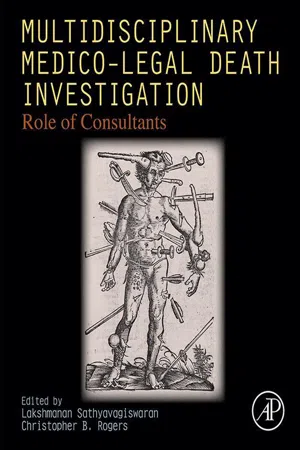
Multidisciplinary Medico-Legal Death Investigation
Role of Consultants
- 414 pages
- English
- ePUB (mobile friendly)
- Available on iOS & Android
Multidisciplinary Medico-Legal Death Investigation
Role of Consultants
About this book
Multidisciplinary Medico-legal Death Investigation: Role of Consultants is the only book in the field that focuses on the role consultants have in medical examiner/coroner offices. The book provides a multidisciplinary view on the topic by including specialized fields, such as anesthesiology, surgery, radiology, including CT scan, pediatrics, cardiology-electrophysiology, cardiac pathology, forensic anthropology and odontology, firearms examination, firearms, eye pathology and psychiatry/psychology. Coverage also includes chapters on specialized topics, including high profile cases, the media, business continuity planning, envenomations, the importance of quality assurance and peer review, and quality assurance in a medico-legal death investigation office.This one-of-a-kind resource is ideal for those in the medico-legal death investigation field and professionals in the criminal and civil justice system.- Covers many fields, including anesthesiology, surgery, and radiology, including CT scan, pediatrics, cardiology-electrophysiology, cardiac pathology, forensic anthropology and odontology, firearms examination, and more- Includes contributions by world-renowned specialists- Presents comprehensive case studies and examples of consultation reports
Frequently asked questions
- Essential is ideal for learners and professionals who enjoy exploring a wide range of subjects. Access the Essential Library with 800,000+ trusted titles and best-sellers across business, personal growth, and the humanities. Includes unlimited reading time and Standard Read Aloud voice.
- Complete: Perfect for advanced learners and researchers needing full, unrestricted access. Unlock 1.4M+ books across hundreds of subjects, including academic and specialized titles. The Complete Plan also includes advanced features like Premium Read Aloud and Research Assistant.
Please note we cannot support devices running on iOS 13 and Android 7 or earlier. Learn more about using the app.
Information
Role of the Cardiac Electrophysiology Consultant
Abstract
Keywords
Introduction
Pacemakers


Table of contents
- Cover image
- Title page
- Table of Contents
- Copyright
- Dedication
- List of Contributors
- About the Authors
- Preface
- Acknowledgments
- Chapter 1. Role of the Cardiac Electrophysiology Consultant
- Chapter 2. Pediatric Consultation: The Value of a Clinical Perspective
- Chapter 3. Role of the Consultant in Forensic Radiology
- Chapter 4. The Role of Virtual Autopsy and Use of a CT Scanner in Medico-Legal Death Investigations
- Chapter 5. Anesthesiology Consults at the Los Angeles County Medical Examiner-Coroner’s Office
- Chapter 6. Coroners’ Surgical Consultation: Q rdr H TO
- Chapter 7. Psychological Autopsy: Consultative Tool for Suicide Determination
- Chapter 8. Role of the Cardiac Pathologist in Evaluating Sudden Natural Deaths
- Chapter 9. Role of the Forensic Odontologist in a Medical Examiner-Coroner’s Office
- Chapter 10. Forensic Anthropology
- Chapter 11. The Value of Eye Pathology Consults in Pediatric Medico-Legal Death Investigation
- Chapter 12. Firearms—Special Topics
- Chapter 13. The Medical Examiner-Coroner and the Firearms Examiner
- Chapter 14. Envenomations: Reptiles and Arthropods
- Chapter 15. High-Profile Cases: The Los Angeles Experience
- Chapter 16. Quality Assurance and Peer Review
- Chapter 17. Quality Assurance in the Los Angeles County Medical Examiner-Coroner’s Office
- Chapter 18. Business Continuity Planning for the Medical Examiner
- Index